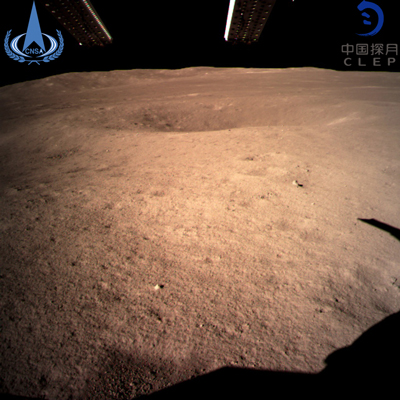Humanity has touched down on the farside of the Moon for the first time. China’s Chang’e-4 mission successfully completed its soft landing on 3 January at 2:26 a.m. Greenwich mean time.

The Moon rotates at the same rate as its orbit around Earth, and so the same hemisphere always faces away from Earth. This is where Chang’e-4 landed, at Von Kármán crater in the South Pole–Aitken basin. This geometry means that the mission’s lander and rover, called Yutu-2, can’t directly communicate with Earth. They will relay their communications through China’s Queqiao satellite, which was launched to the Earth–Moon Lagrange L2 position in May 2018.
The farside of the Moon holds scientific questions and offers opportunities that the nearside does not. Other missions that have orbited the Moon have observed that the farside’s surface is lighter in shade and more heavily cratered than the nearside. This suggests that the farside may have a different impact history or less resurfacing than the nearside.
In addition, the South Pole–Aitken basin may have been the site of a large impact that exposed the lunar mantle billions of years ago. Chang’e-4 aims to pinpoint the age and composition of the farside surface and learn more about the early history of the Earth–Moon system.
This hemisphere of the Moon is also in our radio shadow, a region where the bulk of the Moon blocks most radio emissions from Earth. What’s more, the Moon has no atmosphere to shield the surface from cosmic rays. Chang’e-4 will take advantage of these facts to conduct radio wave, neutron, and cosmic ray measurements that can’t be done from Earth or the Moon’s nearside.
Chang’e-4 was launched by the China National Space Administration on 7 December 2018 as part of the country’s lunar exploration program. Yutu-2 detached from the lander just after touchdown and began making tread marks across Von Kármán crater:
Siesta on lunar far side: After making the historic first tracks on the far side of the Moon, the Yutu-2 rover is going to enter “noon break” sleep mode til January 10, according to China’s lunar program, as a precaution for high temperatures https://t.co/RPHkJjWF2M #ChangE4 pic.twitter.com/NGDwdajXCw
— Andrew Jones (@AJ_FI) January 4, 2019
—Kimberly M. S. Cartier (@AstroKimCartier), Staff Writer
Citation:
Cartier, K. M. S. (2019), Lander gives first look at Moon’s farside, Eos, 100, https://doi.org/10.1029/2019EO113171. Published on 04 January 2019.
Text © 2019. The authors. CC BY-NC-ND 3.0
Except where otherwise noted, images are subject to copyright. Any reuse without express permission from the copyright owner is prohibited.

